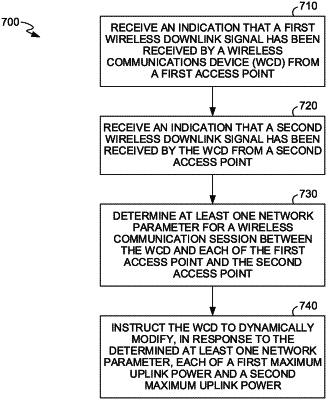| CPC H04W 52/367 (2013.01) [H04W 88/02 (2013.01)] | 20 Claims |

|
1. A wireless communication device (WCD) for dynamically allocating maximum total uplink power comprising:
one or more transmitters configured to transmit a first wireless uplink signal to a first access point and a second wireless uplink signal to a second access point; and
a processor configured to perform operations comprising:
determine at least one network parameter for a wireless communication session between the WCD and each of the first access point and the second access point, the at least one network parameter comprising a realized uplink transmission data rate, a realized downlink transmission data rate, an observed signal to interference plus noise ratio, a received strength receive power, a pathloss, a connection throughput, one or more capabilities of the WCD, or a location of the WCD;
determine a power headroom of the WCD for transmitting the first wireless uplink signal to the first access point; and
in response to the determined at least one network parameter, reduce a first maximum uplink power used by the WCD to transmit the first wireless uplink signal to the first access point by at least a portion of the power headroom and at least partially proportionately increase a second maximum uplink power used by the WCD to transmit the second wireless uplink signal to the second access point by at least a portion of the power headroom to establish and/or maintain dual connectivity with the first and second access points.
|